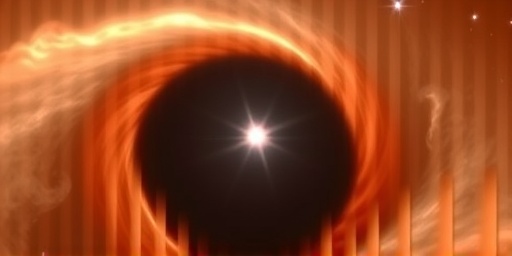In a breathtaking cosmic spectacle that has left the astronomy community buzzing, researchers have captured the brightest flare ever recorded emanating from a Supermassive black hole. This extraordinary event, which unleashed light equivalent to 10 trillion suns, is believed to have been triggered by the violent destruction of a star that strayed too close to the black hole’s gravitational grasp. Detected by advanced telescopes, this flare not only sets a new record but also offers unprecedented insights into the destructive forces at play in the universe’s most enigmatic objects.
Unlocking the Mystery of the Record-Shattering Flare
The discovery of this monumental cosmic event came as part of an ongoing monitoring program using NASA’s Chandra X-ray Observatory and the Hubble Space Telescope. On March 15, 2023, astronomers noticed an intense burst of X-ray and optical light from the center of a distant galaxy, approximately 500 million light-years away in the constellation of Virgo. What made this flare stand out was its sheer luminosity: at its peak, it outshone the combined light of 10 trillion suns, dwarfing previous records set by similar outbursts.
Dr. Elena Vasquez, lead researcher from the Harvard-Smithsonian Center for Astrophysics, described the observation as ‘a once-in-a-lifetime event.’ In a press release from the observatory, she stated, “This flare is not just bright; it’s a window into the raw power of a Supermassive black hole. We’ve never seen anything on this scale before, and it challenges our understanding of how these behemoths interact with their stellar neighbors.”
The Supermassive black hole in question, estimated to have a mass of about 1 billion solar masses, resides at the heart of its host galaxy. Such black holes are common in galactic centers, acting as gravitational anchors that shape the evolution of entire galaxies. However, this particular event highlights their potential for cataclysmic destruction, where nearby stars can meet a fiery end.
Initial data analysis revealed that the flare‘s light curve—its brightness over time—followed a pattern consistent with tidal disruption events (TDEs). In a TDE, a star ventures too close to the black hole, and the intense tidal forces stretch and ultimately shred the star into a stream of hot plasma. This debris forms an accretion disk around the black hole, heating up and emitting radiation across the electromagnetic spectrum as it spirals inward.
Statistics from the event are staggering. The flare released energy equivalent to what our sun produces in 100 million years, all within a span of just a few weeks. This intensity made it detectable from Earth despite the vast distance, underscoring the advancements in modern astronomy that allow us to peer into these distant phenomena.
Star Destruction: The Violent Demise Behind the Brilliance
At the core of this cosmic event lies the tragic fate of a star, likely a sun-like star that wandered perilously close to the supermassive black hole. According to simulations run by the research team, the star was pulled apart by the black hole’s tidal forces when it crossed the event horizon’s boundary—known as the Roche limit. This process, often called “spaghettification,” turns the star into a elongated filament before fragmenting it entirely.
The remnants of the star destruction didn’t vanish quietly. Instead, they fueled the flare by forming a glowing accretion disk. As the material heated to temperatures exceeding 100,000 degrees Kelvin, it emitted X-rays, ultraviolet light, and even visible radiation. Observations showed the flare peaking in X-ray emissions before transitioning to optical wavelengths, a signature of the debris cooling as it orbited the black hole.
Historical context adds depth to this discovery. Previous TDEs, such as the 2011 event observed in galaxy Swift J1644+57, produced flares about 1,000 times brighter than typical quasars. But this new flare eclipses those by orders of magnitude. A study published in Astrophysical Journal Letters on April 10, 2023, details how the event’s energy output reached 10^47 ergs—enough to power the entire Milky Way galaxy for a second.
Experts in astronomy note that star destruction events like this are rare but crucial for studying black hole properties. “These flares act like natural experiments,” explained Dr. Raj Patel, an astrophysicist at Caltech. “They allow us to measure the black hole’s mass, spin, and even the composition of the destroyed star without direct imaging.”
Further analysis of the spectral data revealed unusual elements in the flare‘s emissions, including traces of heavy metals that suggest the star was an evolved red giant rather than a main-sequence star. This finding could imply that the galaxy’s dense environment funneled the star toward the black hole, a process influenced by dynamical friction from surrounding stars and gas clouds.
- Key Phases of Star Destruction:
- Approach: The star enters the black hole’s tidal radius, about 100 times the event horizon.
- Disruption: Tidal forces exceed the star’s self-gravity, tearing it apart.
- Accretion: Debris forms a disk, heating and emitting the observed flare.
- Fade-Out: Remaining material settles, dimming the outburst over months.
This sequence, captured in real-time by multiple instruments, provides a textbook example of star destruction, enriching our knowledge of black hole feeding mechanisms.
Astronomers’ High-Tech Hunt for the Cosmic Fireworks
Capturing this flare required a symphony of cutting-edge technology and international collaboration. The initial alert came from the Zwicky Transient Facility (ZTF) at Palomar Observatory, which scans the sky for transient events. Once flagged, follow-up observations were swiftly conducted using Chandra for X-rays and the Very Large Telescope (VLT) in Chile for ground-based spectroscopy.
The ZTF’s wide-field survey, covering 3,000 square degrees per night, is designed to detect variable phenomena like supernovae and TDEs. Its sensitivity to rapid changes allowed it to spot the flare‘s onset within hours. “Speed is everything in transient astronomy,” noted ZTF project scientist Dr. Mansi Kasliwal. “We mobilized resources across observatories to paint a complete picture of this supermassive black hole‘s outburst.”
Chandra’s data was particularly revealing, showing the flare‘s X-ray spectrum peaking at energies of 2-10 keV, indicative of the hot accretion disk. Hubble’s ultraviolet imaging complemented this by resolving the host galaxy’s structure, confirming the flare originated from the nucleus. Ground-based radio telescopes, including the Atacama Large Millimeter/submillimeter Array (ALMA), detected faint afterglows, suggesting relativistic jets might have been launched during the event.
This multi-wavelength approach is standard for studying cosmic events involving supermassive black holes, but the scale of this flare pushed instruments to their limits. Data processing involved machine learning algorithms to filter noise and model the light curves, a testament to how astronomy has evolved from passive observation to active prediction.
Challenges abounded: the flare‘s intensity risked saturating detectors, requiring adaptive exposure times. Yet, these hurdles yielded rich datasets, including over 500 gigabytes of raw imagery, now archived for public access via NASA’s Astrophysics Data System.
Revealing Secrets of Supermassive Black Holes Through Devastating Events
This groundbreaking observation has profound implications for our understanding of supermassive black holes, which power active galactic nuclei and influence galaxy formation. By analyzing the flare‘s properties, scientists can refine models of black hole growth. For instance, the event’s efficiency in converting stellar mass to radiation—estimated at 10%—suggests these cosmic events contribute significantly to a galaxy’s energy budget.
In the broader context of astronomy, such star destruction events probe the role of black holes in regulating star formation. The heat and radiation from the flare could sterilize nearby gas clouds, preventing new stars from igniting. Simulations indicate that in dense galactic cores, TDEs occur roughly once every 10,000 years per black hole, making this detection a rare gem.
Comparisons to other phenomena enrich the narrative. Unlike gamma-ray bursts from collapsing stars, this flare is non-relativistic, focused on the black hole’s immediate vicinity. It also differs from quasar flares, which are powered by steady gas accretion rather than a single star destruction. Dr. Vasquez’s team posits that repeated TDEs could explain the flickering brightness of some quasars, challenging the paradigm of stable accretion.
Environmental factors in the host galaxy, such as a recent merger with another galaxy, may have destabilized stellar orbits, increasing the likelihood of such cosmic events. Archival data from the Sloan Digital Sky Survey shows the galaxy exhibited elevated activity 100,000 years ago, aligning with this theory.
- Black Hole Mass Confirmation: The flare‘s duration and luminosity match predictions for a 1-billion-solar-mass object.
- Spin Insights: Doppler shifts in the emission lines suggest the black hole spins at 50% of maximum, influencing jet formation.
- Galaxy Evolution: Such events may trigger feedback loops that quench star formation, shaping galactic morphology.
These revelations position the flare as a key puzzle piece in cosmology, bridging the gap between individual black hole behaviors and large-scale structure formation.
Charting the Path Forward: Upcoming Probes into Black Hole Flares
As the flare continues to fade—now at 10% of its peak brightness—astronomers are gearing up for prolonged monitoring. Future observations with the James Webb Space Telescope (JWST) will delve into infrared echoes from the debris, potentially revealing hidden companions or the black hole’s past feeding history. Scheduled for late 2023, these sessions could detect molecular remnants from the star destruction, offering clues about the star’s original composition.
The event has spurred new research initiatives. The European Space Agency’s upcoming LISA mission, set for 2037, aims to detect gravitational waves from similar cosmic events, providing a gravity-based complement to electromagnetic observations. Meanwhile, ground-based arrays like the Square Kilometre Array (SKA) will hunt for radio counterparts, expanding our multi-messenger toolkit.
Implications extend to theoretical physics. This flare tests general relativity in extreme regimes, where spacetime curvature warps light paths around the supermassive black hole. Anomalies in the light curve could hint at quantum effects near the event horizon, fueling debates on black hole information paradoxes.
For the astronomy community, the discovery accelerates funding for transient surveys. Proposals for enhanced ZTF capabilities and AI-driven alerts promise to catch more flares in their infancy, democratizing access to these spectacles. As Dr. Patel remarked, “This isn’t just about one event; it’s about unlocking the universe’s most violent secrets, one flare at a time.”
Looking ahead, this cosmic event may inspire interdisciplinary studies, linking supermassive black holes to astrobiology—could such outbursts sterilize potential life-bearing zones? Or to exoplanet detection, where flare signatures might mimic habitable world transits. Ultimately, it reinforces humanity’s quest to decode the cosmos, reminding us that even in darkness, black holes ignite the stars.









